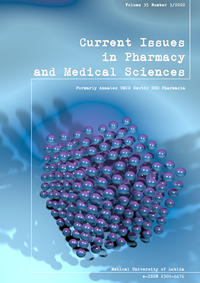The drug safety information in domestic medical literature
DOI:
https://doi.org/10.2478/cipms-2022-0021Keywords:
adverse drug event, adverse drug reaction, literature search, literature monitoringAbstract
Medical literature is an important source of drug safety information relevant for signal detection, safety profile analysis and risk-benefit assessment. The main goal of our study was to assess the utility of domestic medical literature as a source of drug safety information. All safety information identified for active substances published between 1.01.2018-31.12.2019 in domestic medical journals published in Poland were analyzed. Four thousand seven hundred eighty-nine drug safety information was reported for 500 active substances. Two thousand and forty-four submissions dealing with drug safety (48.28%) were identified in the 10 journals from the list of analyzed journals (3 of these were identified in the 2019 JCR and 5 of these were indexed in the main scientific databases and 9 of these had an affiliation to scientific society). There was a correlation between journal impact factor and scientific database indexation with the number of published individual literature reports and type of safety information. Journals publishing in Polish constituted source for about 40% of all safety information published in the examined period. Journals indexed in Medline were the source of about 37% of all safety information while 42% was published in Embase. Local medical literature is a source of valuable safety information but the list of journals for monitoring should be carefully selected with particular attention to journals with impact factor.References
1. European Medicines Agency (EMA). Guideline on good pharmacovigilance practices (GVP) Module VI – Collection, management and submission of reports of suspected adverse reactions to medicinal products (Rev 2). 2017.
2. Rymarczuk A, Bielski M, Lozak K, Ochyra B, Szewczyk M, Miernecka D, et al) Dobór czasopism medycznych wydawanych w Polsce dla celów przeglądów lokalnej literaratury medycznej w zakresie bezpieczeństwa stosowania produktów leczniczych. – Standard Polskiego Towarzystwa Bezpiecznej Farmakoterapii (PTBFarm). Biuletyn Bezpieczenstwa Produktow Leczniczych. 2020;15(1).
3. Ferguson J, Mockbee C, Erbele S, Muniz E. Evaluation of Published Case Reports’ Standards and Notification. Drug Inforn l. 2002;36:303-7.
4. Hauben D, Aronson J. Gold Standards in Pharmacovigilance. Drug Safety. 2007;30:645-55.
5. Impicciatore P, Mucci M. Completeness of published case reports on suspected adverse drug reactions: evaluation of 100 reports from a company safety database. Drug Saf. 2010;33(9):765-73.
6. Kelly WN. The quality of published adverse drug event reports. Ann Pharmacother. 2003;37(12):1774-8.
7. Pontes H, Clément M, Rollason V. Safety signal detection: the relevance of literature review. Drug Saf. 2014;37(7):471-9.
8. EMA. 2021 Annual Report on EudraVigilance for the European Parliament, the Council and the Commission, EMA/719826/2021, 2022.
9. Chinoy MA, Ahmad T, Tayyab MA, Raza S. Evidence based medicine – where do articles published in local indexed journals stand? JPMn. 2009;59(1):5-9.
10. Kelly WN, Arellano FMmuBarnes J,-Bergman U, Edwards IR, Fernandez AM, et al. Guidelines for submitting adverse event reports for publication. Pharmacoepidemiol Drug Saf. 2007;16(5):581-7.
11. Shetty KD, Dalal SR. Using information mining of the medical literature to improve drug safety. I Am Med Inform Assoc. 2011;18(5): 668-74.
Downloads
Published
Issue
Section
License
Copyright (c) 2022 Authors

This work is licensed under a Creative Commons Attribution-NonCommercial-NoDerivatives 3.0 Unported License.


